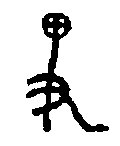2. The use of hakaturou in the rongorongo texts is connected with cardinal points. In ancient Egypt arms of gods held up the sky:
Although this picture (from Wilkinson) has kings instead of gods, the idea is the same: Mighty powers are needed. "Among the multitude of gods worshipped by these people [the Maya] were four whom they called by the name Bacab. These were, they say, four brothers placed by God when he created the world at its four corners to sustain the heavens lest they fall." (Diego De Landa according to Hancock) Winter solstice, for instance, is in the calendar of K illustrated as a straight mighty 'arm', presumably in order to tell about how the sky from now on must be pushed up to let in light again:
Viri (Kb4-6) probably implies a 'corner in time-space'. The oval in Kb4-8 illustrates a complete cycle, and the 5 marks inside means 5 'in the dark' - presumably standing for those 5 days beyond the end of the regular 180 days (3 solar double-months) of the 2nd half of the old year (before which a new regular year can begin). Kb4-7 may be a picture of a gnomon: 'The most ancient of all astronomical instruments, at least in China, was the simple vertical pole. With this one could measure the length of the sun's shadow by day to determine the solstices ... and the transits of stars by night to observe the revolution of the sidereal year. It was called pei or piao, the meaning of the former being essentially a post or pillar, and the latter an indicator. Pei can be written with the bone radical ... or with the wood radical, in which case it means a shaft or handle. Ancient oracle-bone forms of the phonetic component show a hand holding what seems to be a pole with the sun behind it at the top ...
so that although this component alone came to mean 'low' in general, it may perhaps have referred originally to the gnomon itself. This is after all an object low on the ground in comparison with the sun, and shows the long shadow of a low sun at the winter solstice, the moment which the Chinese always took as the beginning of the tropic year.' The hand is there, the low sun is there, the straight pole is there. And the sun symbol at the top of the Chinese gnomon could in rongorongo very well be illustrated as a round fist - the fingers are 'inside', in the dark (fingers, rima, are connected with fire). |



